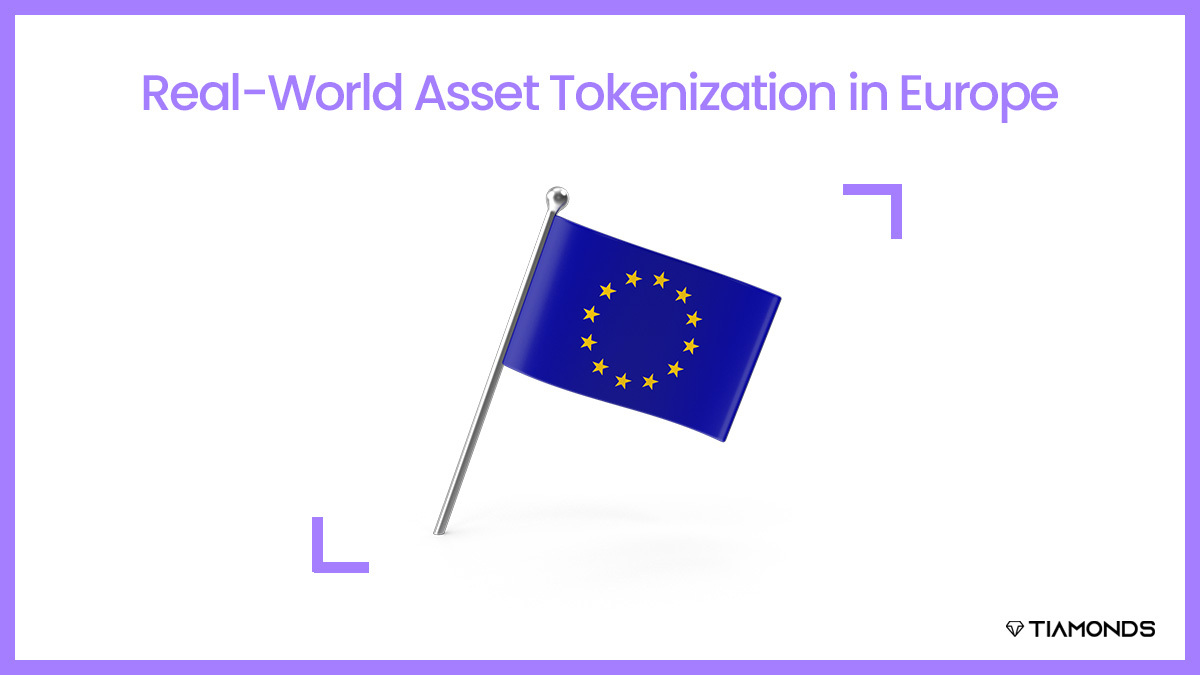The European market for digital tokenization is experiencing significant growth due to factors such as institutional acceptance, regulatory clarity, and a wide range of applications. Despite the persistence of obstacles such as workforce upskilling and interoperability. The market exhibits tremendous potential in terms of sector-wide efficiency, security, and liquidity while establishing a positive environment for real-world asset tokenization in Europe
as a champion in this revolutionary technology.
Table of Contents:
ToggleA Brief Overview of Real-World Asset Tokenization in Europe
The market of digital real-world asset tokenization in Europe represents an exceptionally profitable environment for enterprises. Progressive regulatory strategies significantly impact the established market share of the region, which amounts to around 25% of the global tokenization market, as of 2022. The MiCA regulation, which prioritizes financial stability, consumer protection, and innovation, distinguishes the European Union as a significant catalyst.
By providing transparency and a cohesive structure, it empowers cryptocurrency enterprises to operate with assurance within the European Union. With the ultimate goal of eliminating regulatory defects by 2024. Astute Analytica asserts that positive consumer sentiment serves to reinforce the potential of Europe. By 2021, an estimated 35% of the adult population in Europe had engaged in cryptocurrency investments or utilized tokenized assets. We anticipate a significant increase in this percentage by 2025. This demonstrates that public confidence and acceptance of the advantages of this technology are increasing. In spite of this, reports indicate that more than sixty percent of European institutional investors intend to increase their exposure to tokenized assets. This is a clear indication of their confidence in the market’s long-term viability.
Added Benefits
This advantageous environment has stimulated innovation across sectors. Prominent financial institutions throughout Europe are incorporating tokenization platforms that have extensive applications into their operations. The issuance of €100 million in bonds in 2019 in the form of security tokens is a prime example. European nations have collectively invested over €350 million in blockchain initiatives, demonstrating their commitment to this foundational technology.
In relation to MiCA specifically, the regulatory landscape harmonization it facilitates is expected to enhance the appeal of Europe for crypto enterprises. MiCA strives to protect European consumers’ interests and foster innovation. All within a framework that aims to halt market manipulation and prevent misuse. The regulatory framework known as MiCA prioritizes stablecoins, enforces transparency through the publication of whitepapers, and fortifies consumer protections to foster an environment conducive to the growth and success of both conscientious enterprises and ordinary investors.
Market Trends to Watch for Real-World Asset Tokenization in Europe
Institutional Adoption Increase
The development of tokenized funds and assets by major financial institutions such as BlackRock, JP Morgan, and Hamilton Lane indicates an increase in mainstream adoption.
Institutional customers’ physical gold in HSBC’s London vault has undergone tokenization.
The World Bank issued a digital bond using Euroclear’s DLT solution.
Regulated entities will tokenize cash, starting with the largest banks issuing stablecoins, e-money, and deposit tokens.
Real-World Asset Tokenization in Europe
Tokenizing tangible assets such as intellectual property rights, real estate, art, commodities, and securities has generated tremendous interest and potential.
RWA tokenization has the potential to exchange hundreds of trillions of dollars on-chain and revolutionize the cryptocurrency and financial sectors.
Advantages include increased liquidity, decreased asset transfer friction, and enhanced access to the global market.
The Digital Asset Landscape in Europe
Aware of the European market’s potential, industry leaders in cryptocurrencies, are expanding their operations there. This growth serves as an indication of the region’s increasing significance within the worldwide digital asset ecosystem and its appeal as a location for cryptocurrency enterprises.
The real-world asset tokenization in Europe is making preparations to implement a stablecoin based on the euro. The primary objectives of this endeavor are to bolster the stability of the European markets, furnish investors with a digital currency that eradicates the risk of exchange exposure, And potentially expand the adoption of the euro within the realm of digital assets. When contrasting the United States, whose regulatory approach to digital assets is considered more fragmented, with Europe’s unified MiCA regulation, the latter may potentially attain a leadership position in the market. The MiCA framework, considered a global benchmark, has the potential to influence other regions. Including the United States, to implement comparable comprehensive regulatory measures.
The European Union imposes a comprehensive regulatory framework on tokenization corporations. Crucial regulations comprise
The Markets in Financial Instruments Directive II (MiFID II) has come into effect.
Markets in Financial Instruments Regulation (MiFIR)
6th Anti‑Money Laundering Directive (AMLD6)
The Markets in Crypto-Assets Regulation (MiCA)
The Basel III Extension
Regulations require tokenization companies to establish and enforce stringent customer identification and due diligence protocols. Ensuring adherence to anti-money laundering (AML) and know your customer (KYC) regulations is critical for upholding transparency and financial security.
To Conclude
As we draw to a close on our investigation into the dynamic realm of digital assets and tokenization in diverse international locations. It becomes apparent that the financial sector is undergoing an unprecedented revolution. The real-world asset tokenization in Europe of tangible assets has significantly transformed blockchain finance, offering enhanced liquidity, fractional ownership, cost effectiveness, and transparency. Effective collaboration among regulatory entities, tokenization companies. And advanced Know Your Customer (KYC) solutions is imperative to fully harness the capabilities of real-world asset tokenization within a secure financial environment.




